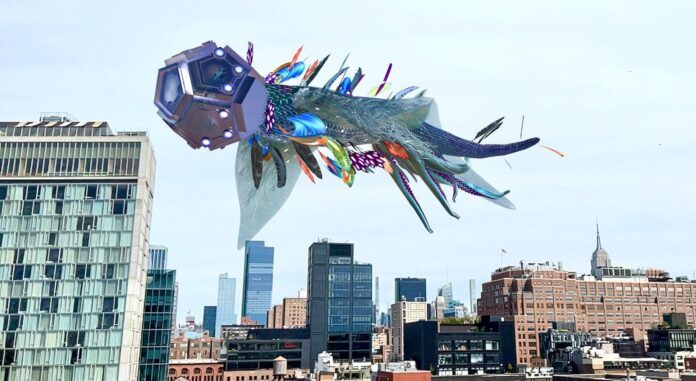A mesmerising hybrid creature—part mycelium, part cephalopod, part bird and part machine—will loom over New York’s Meatpacking District starting 3 October as part of the Whitney Museum of American Art’s latest digital-art commission, CENTO (2023), by the new-media artist Nancy Baker Cahill. A site-specific augmented reality (AR) work, the interactive project addresses the need for interspecies cooperation in the face of the climate crisis from an ecosophical approach, which criticises the traditional separation of humans from the natural world.
The chimeric creature was born from the need for alternative ecological communities and modes of communication, according to the artist, and draws from various philosophical and science-fiction texts to explore the existential challenges of the climate crisis. One particular influence is Jeff VanderMeer’s 2017 short story The Strange Bird: A Borne Story, in which a bird-like creature acts as a metaphor for hybridity gone awry, tackling questions around survival and adaptability.
“I was interested in the overshoot of planet collapse, which is inextricably linked to societal collapse,” Baker Cahill tells The Art Newspaper. “We’ve hit an inflection point around synthetic biology and bioengineering, and Cento, in particular, responds to the question: what will life become? It’s going to require a profound reckoning to create interdependence between species.”
Visitors can interact with CENTO from various points in and near the museum by downloading the free, Baker Cahill-designed 4th Wall app, where they can contribute to the creature’s evolutionary development by adding one of 12 feathers—each with its own biological function. The main viewing spot will be the sixth-floor terrace, but CENTO will also be visible from other terraces at the museum, as well as from the adjacent High Line and online.
“It’s exciting to imagine the unintentional communities that could spring out of this, which is something that happens all the time with AR, particularly with public AR projects,” Baker Cahill says. “CENTO is a work of ecological imagination—an experimental, living test for community-building and adaptability in this hugely destabilised moment. The word bioengineering is not generally positive. It’s an alarming thought, because it’s tied to militaristic, corporate, capitalist and extractive interests. But what would happen if we could create an evolutionarily resilient, transpeciated creature? What would it be like to have a collection of different organisms existing as a single entity?”
The word cento (Latin for “patchwork”) is used to describe a collage poem, comprised of lines lifted from various other poems. Baker Cahill came across the term while working on a short film, The Quivering and Lively Nerve of the Now (2023), which references the Ukrainian Brazilian writer Clarice Lispector and her 1973 novel Água Viva.
“I was pulling the most evocative or compelling phrases that I could find in the book and putting them together in order to visualise or materialise the words as I experienced them,” Baker Cahill says. “Without even knowing it, I was creating a cento, and that term became the perfect metaphor for CENTO, which metabolises this idea that we are all centos ourselves—made up of millions of thoughts and existences—although we tend to think monolithically. The work celebrates the multiplicity of what we are, and considers how addressing the challenges of ecocide from a collaborative (or more pastiche, collaged) approach makes sense.”
CENTO is the first interactive AR commission commissioned by the Whitney and will be stored on artport, a digital exhibition space and archive for new-media works launched in 2001 by the Whitney’s curator of digital art, Christiane Paul. Artport also houses a number of other collaborative internet projects that address coexistence from poetic, community-minded approaches. One of the earliest is The World’s First Collaborative Sentence (1994; restored 2013) by Douglas Davis, which invites participants to contribute to an infinitely expanding sentence using a programme that functioned between 1994 and 2005, and has been live without interruption on artport since 2013. Like with CENTO, the work was envisioned as having “no end” and perhaps “no beginning”, Davis said in 2000.
“Augmented reality is always a great annotation of reality, and the engagement aspect of CENTO in particular is very interesting and specific,” Paul says. “There’s something quite majestic about seeing this creature suspended from the sky—a creature that we are engaging with in real time—rather than seeing a work that is contained within a room or a screen, for example. Participatory AR is still a fairly new concept, and CENTO is pushing the boundaries of what that means.”
- Nancy Baker Cahill: CENTO, on view at the Whitney Museum of American Art, New York, and online starting 3 October

























